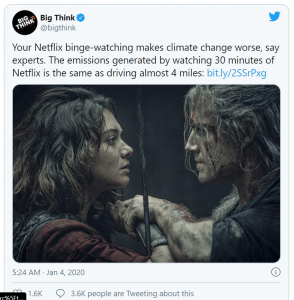Canceled holiday trips, postponed music festivals, closed cinemas, lost jobs, suspended contracts and stringent social distancing rules in full swing – these are just a few examples of the grim consequences of COVID-19. The virus has spared no one, and how it is changing our lives may not have fully unfolded yet… Suffice it to say 2020 did not pan out exactly as most of us had planned.
But hey, as the Pythons sang, always look on the bright side of life, right? There must be a positive aspect of the pandemic, after all! And once you think about it, there are a few, actually. For one, we stopped driving our cars to work and polluting the air so much. Many of us do more sports. Many of us also read more books and spend more quality time with the family. Then, those of us who could, have made the switch to remote work. Lastly, with limited options left for entertainment, we’ve finally found some time to catch up with all the Netflix series and films on our “watch later” lists (read more about the viewing habits during the lockdown).
We just gave the earth a breather, right? Well, wrong. According to some reports, even your innocent Netflix binge kills the planet.
Before you drink the Kool-Aid, bear in mind that such reports are to be taken with a pinch of salt and are only meant to amass more shares and gain bigger reach. In reality, the environmental impact may be much harder to estimate and is not nearly as severe as some media outlets make it seem.
The doomsayers’ gospel
There is always this one person who ruins the party. Someone who stifles every slightest glimmer of hope, and makes everyone feel guilty for feeling good. And such was the presumed role of the Climate Crisis: The Unsustainable Use Of Online Video report by a Paris-based think tank The Shift Project. The report coins the concept of digital sobriety, and argues that internet use is not as dematerialized as people assume and actually harms the planet. They use seemingly solid data to support the claim and argue that electricity spent in the process of video streaming in 2018 alone was equal to 96 percent of the electricity used in all of Spain in 2011.
For a more striking analogy, a recent tweet from Big Think said that streaming the Netflix original series Stranger Things 64 million times resulted in over 189m kg of CO2 emissions, which is the equivalent of driving a car for 420 million miles.

We already sense your blood pressure building up along with the burning need to click “share” and cause outrage and distress in your Facebook friends. But please don’t spread the bad gospel just yet.
In this post, we’ll take a quick look at the shocking statistics and hopefully calm you down a bit.
The claimed environmental footprint of streaming seems exaggerated
Streaming is not as computationally intensive (and power consuming) as some people make us believe it is. For one, most streaming happens from geographically close CDNs which are designed to minimize the distance between the content and the user, and streamline the delivery by preparing the video content in several quality and audio versions in advance. This means there is, in fact, very little computing done on the way to your device.
At the same time, what people seem to forget is that the usual alternatives to video streaming would typically involve much more CO2 pollution, i.e.
- driving a car to the cinema, or
- driving a car to a Blu-Ray store, buying a movie (enclosed in an environmentally unfriendly box) and driving back home to watch it. Arguing that doing so is more carbon-neutral than streaming is not only hard to believe, but simply silly. Or,
- downloading a pirate copy of the film from remote servers which may not use a CDN to optimize the content delivery process. Remember that pirates care even less about the environment than Netflix, Amazon and Hulu combined. And there is no one to hold accountable, too.
The car driving vs streaming comparison is at odds with the facts
While admittedly shocking at first glance, the statistics used in the Shift Project’s report don’t add up and ignore many key factors. A bit of fact-checking reveals where they miss the point:
- While it is true that video streaming causes CO2 emissions, the actual numbers are much less alarming, and nowhere near the 0.9kg in CO2 emissions for a single episode. According to a study published in the peer-reviewed journal Environmental Research Letters in 2014, streaming video for 30 minutes results in 0.2 kilograms of CO2 emissions.
- By comparison, driving for 30 minutes emits roughly 1.8 kilograms of CO2 for four miles (that’s including combustion emissions, gasoline production and transportation, and vehicle manufacturing for a car that takes about 9.4 liters/100kms).
If you do the math right, driving a car over a distance of four miles actually produces about nine times as much carbon pollution as streaming a 30-minute episode of Friends.
The above fact checking simply shows that some reports are designed to shock while not necessarily doing the due diligence to get the numbers right. This is not surprising, as shocking facts are more shareworthy.
The hardware that runs the web is actually becoming more energy efficient
Processors, hard drives, data center hardware and infrastructure – all these pieces of technology are built to consume less and less energy each year. In fact, the amount of electricity consumed in the process of transmitting information over the internet has been cut in half every two years since 2000, according to research published in 2017 in the Journal of Industrial Ecology.
This is nicely illustrated by the diagram below.

The improvements in the energy efficiency of data centres, networks and devices (source).
There are many other culprits behind the relatively slow efficiency gains in computing technologies, but they are completely ignored by the report. Artificial intelligence (AI) and blockchain are expected to have a much bigger overall environmental impact over the coming decades.
What the giants do to save the planet
Home entertainment services use massive data centers to power everything we stream, and those data centers use a lot of electricity, which no doubt originates as fossil fuels. The good news is, streaming services and tech giants are under increasing pressure to reduce their carbon footprints.
Various pledges from the tech world start pouring in to put us at ease. The claims are bold, and although quite hard to verify and enforce, admittedly sound promising.
- Amazon Web Services (infrastructure used by both Netflix and HBO), announced in 2019 the construction of three new wind farms as part of its goal toward 100 percent renewable energy.
- Apple aims to reduce emissions by 75 percent in its manufacturing chain. This would involve recycling more of the components they use and requiring that their suppliers use renewable energy. The remaining 25 percent of emissions would be offset by funding reforestation projects. The company also said it planned to improve energy efficiency in its operations.
- Google said it would no longer build customized AI or machine learning algorithms for the oil and gas sector. It has also pledged to include recycled material in its devices, including its popular Chromebook computers by 2022.
- Facebook announced that it would use 100 percent renewable energy in its facilities and reduce water use in its data centers, though it has said little about what it will do to stop the spread of climate disinformation on its platform.
Conclusion
The whole “streaming pollution” drama has gotten a little out of hand, as quick fact checking reveals the evidence to support the argument is a little flimsy.
For what it’s worth, we’ve learned that:
- Selective evidence and statistics can sometimes serve as a malleable substance which can be molded to conveniently support virtually any argument
- The whole sustainability movement is often too much about pointing fingers at others and too little about doing something on your own.
There are dozens of ways people could cut emissions without sacrificing much. The problem is we don’t really want to. Evidence? There you go: for every gram of beef produced, 221 grams of carbon dioxide are emitted. So, an average steak (225g of beef) translates to 49,725g in CO2 emissions. By comparison 200g of CO2 emissions are produced when streaming a 30-minute episode on Netflix. If given a choice, would you rather quit beef for life or never watch Netflix again?
Obviously, for most of us, it would be so much easier and more effective to save the planet by quitting beef. And yet global meat production has increased by more than 370 percent since 1960, consuming inordinate amounts of global resources and areas of land in the process.
If people really wanted to apply science and show they care about the planet, they’d simply stop eating beef (while still eating pork and chicken). That’s not much to ask.
If you find this article valuable, you can share it on social media →
Read more about the VOD & OTT Industry!
October 27, 2023
The power of video analytics: optimize video content with data
Learn how video analytics measures ROI, improves user experience and enhances content strategy!
June 29, 2023
LightningJS takes the development world by storm, but why?
The pursuit of discovering new, powerful tools lead to the rise of Lightning JS. What are the benefits of this popular TV app framework?
June 15, 2023
Signs of outdated frontend part 2: More red flags
Old practices may get in the way of the success of your solution. Lear the top signs of outdated frontend in our second take on this topic.
Are you looking for a partner to build a Video Solution?
Leave your email and a short description about your project. We would gladly discuss different cooperation possibilities!





